If you had told someone in the early 2000s that you would email them every week with interesting content if they just paid you $10 per month, they’d have gawked.
Heck, if you’d have asked them to sign up for free to receive emails every day or week, they still probably wouldn’t have done it.
Now, newsletters are commonplace.
This indicates an important shift in the world of email marketing — where people used to be wary of spammers (and still are to some degree), they now understand that well-crafted emails can be a “product” all on their own.
So how do you create a successful email newsletter from A-Z?
Here are 7 steps.
1. Finding Your Niche
You could build a successful email newsletter without a clear-cut niche — you could go the David Perell style, for example, and just allow you to be your brand.
But it’s going to take some time. Without a niche or a unique selling proposition, you’ll have to spend months or even years building a trustworthy reputation (think of Tim Ferriss or Joe Rogan).
Choosing a niche, on the other hand, makes your newsletter more marketable. Consider, for instance, which pitch is more compelling to cold traffic…
Hey, I’m Alec and I’ll send you interesting content every week if you sign up below!
Want to receive new business ideas every week from our team of experienced venture capitalists? Sign up below!
If you want to grow your newsletter quickly, then find your niche and create a compelling elevator pitch for your target market.
It might be helpful to think of niches as Russell Brunson does. He starts with the three main markets — health, wealth, and relationships — and recommends that entrepreneurs go three levels deep to find their niche.
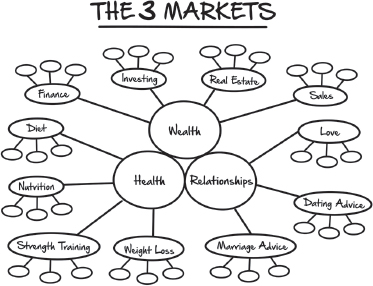
The first level is choosing which of the three markets you’re going to operate within.
The second level is choosing a sub-market (for which there are hundreds of options) — if I chose health as my main market, then I might choose diet as my sub-market.
And the third level is your niche — with diet as my sub-market, perhaps I will choose paleo meal plans or vitamin & supplement advice as my niche.
Once you’ve gone through this process and made a decision about your niche, fill in the blanks…
My niche is _______ and I’m going to serve people who _______. Every week, I’m going to send my audience _______. People will sign up because _______.
Example: My niche is paleo meal plans and I’m going to serve people who want to get healthier by switching to a paleo diet. Every week, I’m going to send my audience a new meal plan with a grocery list and links to recipes. People will sign up because this makes their lives easier and it helps them eat healthier.
Work on this until you’re confident that you’ve got a compelling foundation for your newsletter.
The Browser is one example of a newsletter that nailed its niche.
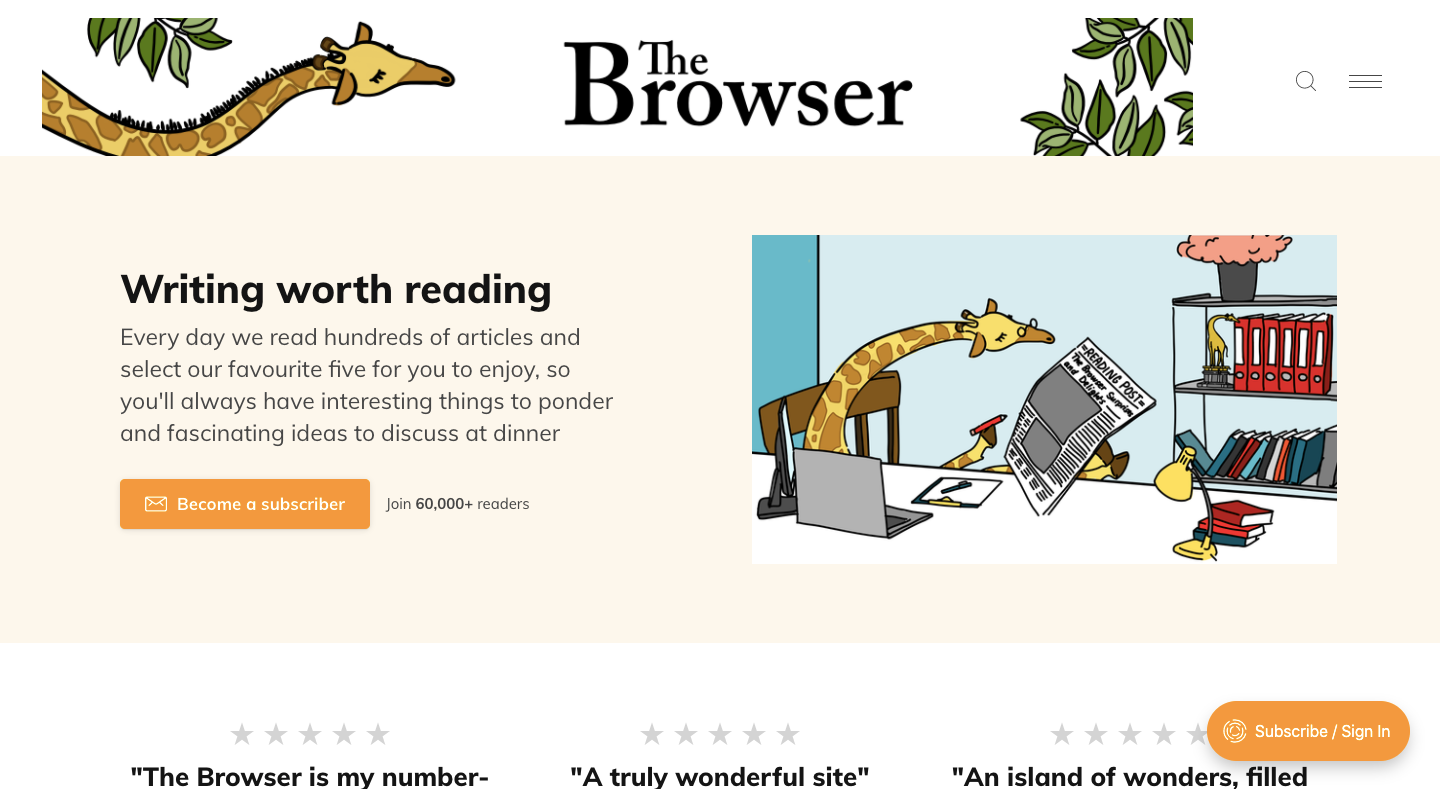
2. Designing Your Email Newsletter
Maybe it doesn’t seem like branding and designing is something you should worry about when creating your newsletter.
But whether you’re using your personal brand or your business brand, branding is critical.
Even more than other types of emails, newsletters depend on building a relationship with your audience… because the emails are the “product.”
And the last thing you want is for people not to open because they don’t immediately recognize your brand.
So it’s worth spending a bit of time (and money, if necessary) to create a consistent and easily recognizable brand image. At the very least, create a logo and choose your brand colors.
My business partner and I just launched this newsletter — The Tonic — and it took us a couple of months just to nail the branding.
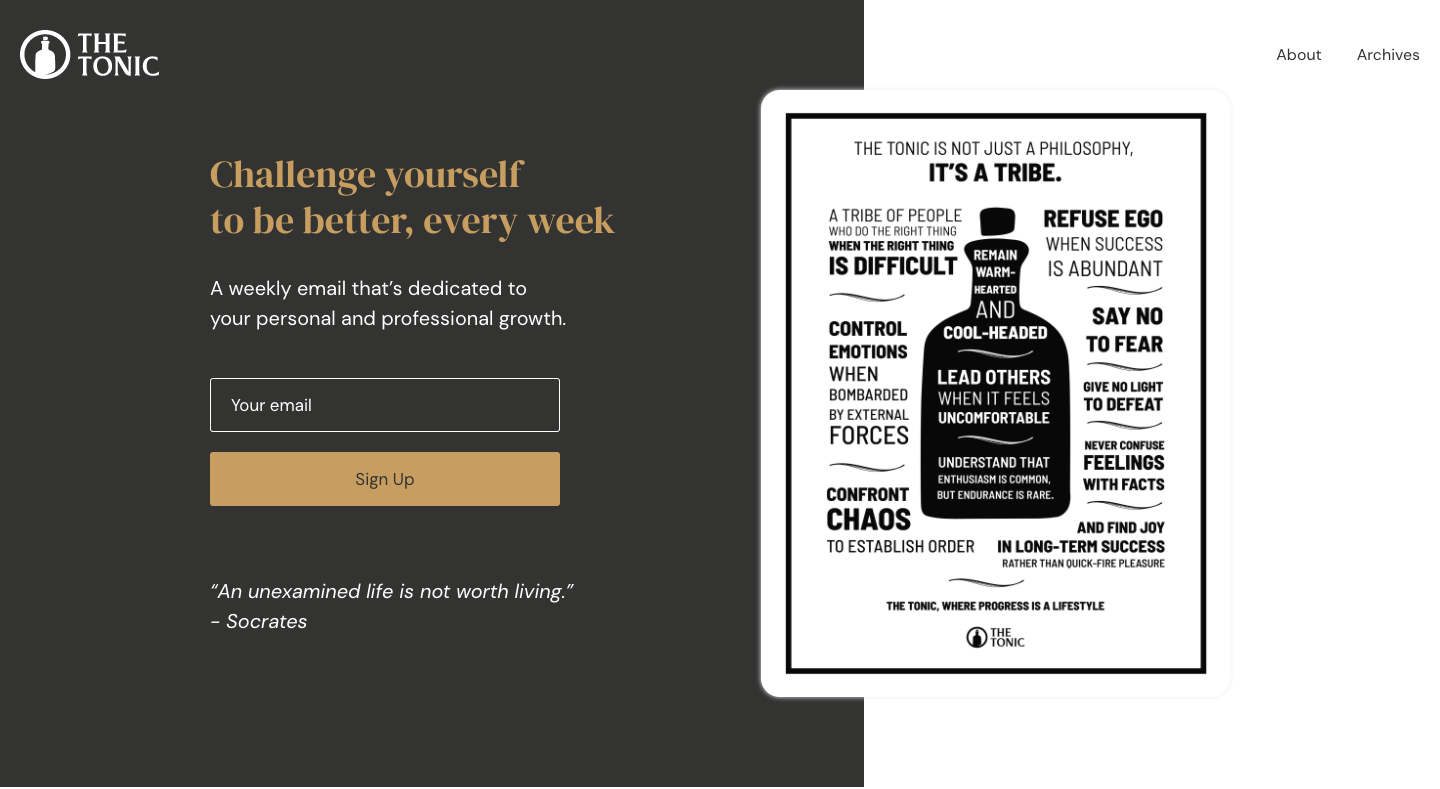
While we’re on the topic of designing your email, we recommend including the following elements…
- Share Request — Ask people to share your emails with a friend, whether through forwarding or through posting on social media. And remember to include a link for those “friends” to go subscribe to your newsletter if they like what they see.
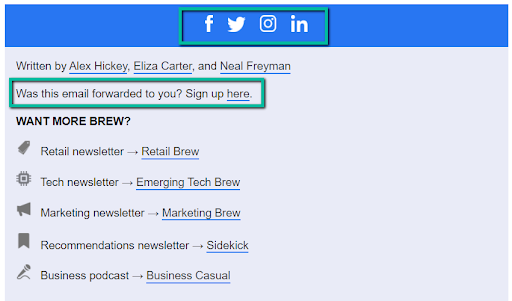
- Feedback Loop — It’s important that you know what your subscribers think of your newsletter content after they open. So we recommend adding some sort of feedback loop. Maybe people can click on an emoji at the bottom of your email indicating what they thought of it or maybe they can click a link to take a quick survey.

- Consistent Branding — As we already discussed, make sure that all of your emails are easy to recognize based on your branding and “From” name.
3. Choosing The Right Tools To Support Your Email Newsletter
You’ve decided on a niche for your newsletter and you’ve created mission-critical design elements.
Now it’s time to choose the tools that you’ll use to collect emails, grow your email list, and send content to your subscribers.
The first thing you’ll need is an ESP (or Email Service Provider). Our personal favorite is Klaviyo — this will allow you to build an email list, create simple opt-in forms, build segments and automated sequences, and send campaigns.
(Plus, Klaviyo’s pricing is based on your number of current subscribers, so it fits any budget)
From there, you’ll want to have a website or platform where people can learn more about your brand. But this doesn’t need to be complicated. The Hustle, for instance, has just a one-page website for collecting subscribers.
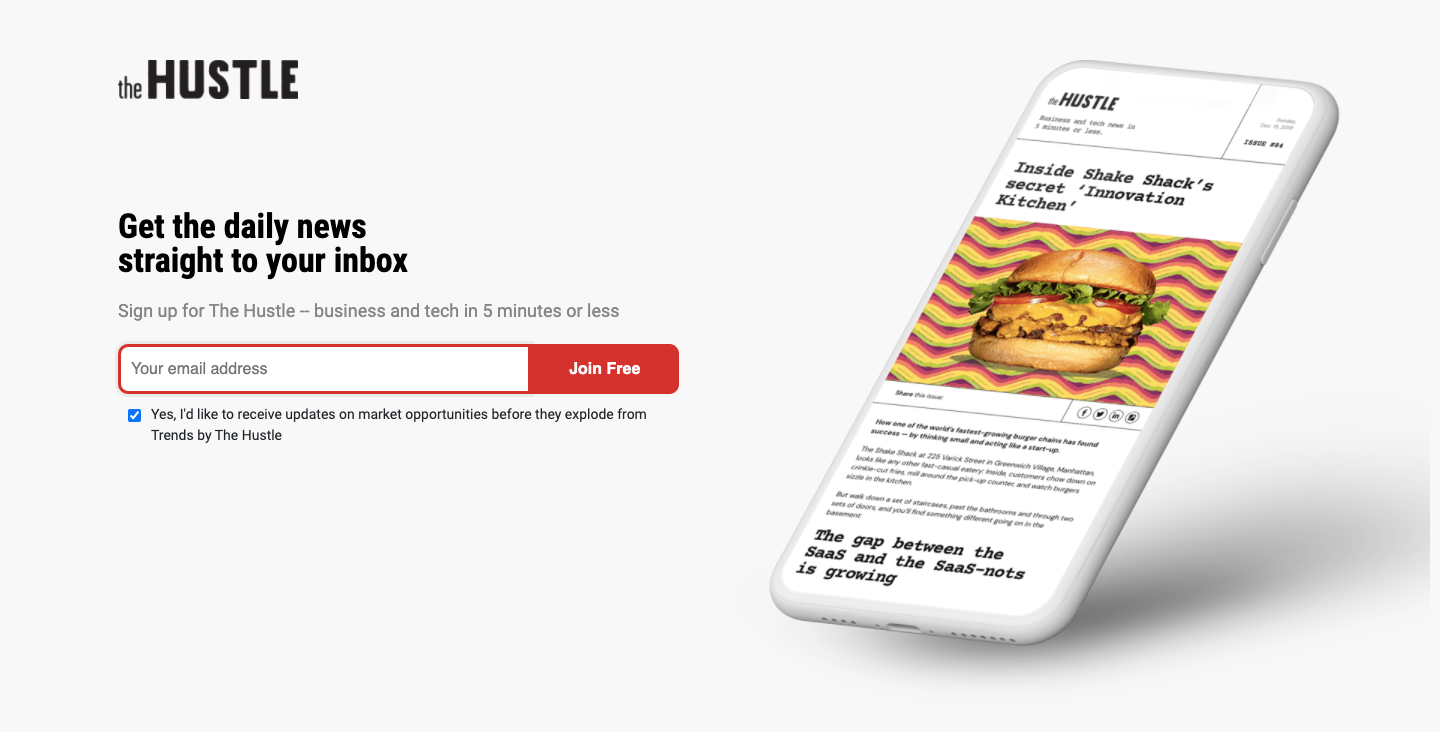
You can use a tool like WordPress or Wix to design your website. Alternatively, you could start by hosting your newsletter on a platform like Substack, which is designed for newsletter email creators.
Divi is probably the best visual editor for WordPress if you’re doing the design work yourself. Otherwise, you could always pay someone to do it for you (you can find great designers on UpWork).
You might add other tools to your repertoire down the road, but those tools should get your newsletter off the ground.
4. Getting Your First Newsletter Subscribers
Now it’s time to create your opt-in forms, build your landing page, and get your first subscribers.
Again, your landing page does not need to be complicated. It should simply and briefly explain what people will receive if they sign up.
Here’s an example from Morning Brew (what you see here is literally the entire page)…

And here’s another example from InsideHook…

(Make sure you connect this form to your ESP so that sign-ups automatically get loaded into your email list — and test it before you launch)
It’s also important to create a welcome email that introduces new subscribers to your email and sets expectations. Here’s an example of what this looks like from The Tonic.

From here, the goal is to drive as much traffic to that page as possible. We recommend exhausting all of your personal connections to help get it off the ground — tell your friends and family and post about it on your social media profiles.
You can also share your new venture on sites like Product Hunt and Indie Hackers.
You might consider hosting a giveaway, creating a free lead magnet, building a referral program (consider SparkLoop), or doing “trades” with other relevant newsletters and email marketers (“you share my newsletter with your audience and I’ll share yours with mine”) — although that last tactic will be a little easier once you have a few thousand subscribers.
In step 7, we’re going to talk more about growing your email list over the long-term. But for now, your goal should be to get past at least the 100-subscriber mark.
5. Creating Engaging Content For Your Newsletter
If we’d titled this guide, “How To Create an Email Newsletter”, then we’d be just about done by now.
But let’s not forget the second clause of that title: “an email newsletter that people want to read.”
That’s critical.
With a newsletter, the emails are the product, so to speak. If your emails are unengaging, and if people aren’t getting in the habit of opening your emails simply because they love them… then you’re going to struggle to monetize or grow.
So… how do you create great content?
Here are some tips…
Find The Substance
Every email you send should have substance. That is, it should mean something to your subscribers.
Maybe that substance is found in providing valuable and timely information, maybe it’s found in humor or inspiration, or maybe it’s something else.
Whatever the case, every email needs substance. Check out this email from InsideHook and notice how often they provide entertainment and real value for their reader.

Create Dopamine Hits
Why do people open (or not open) your emails?
Well, it’s a simple answer: people open (or don’t open) because they want to see what’s inside the email. An expectation has been set. Maybe the subject line caught their attention or maybe they’re trying out your newsletter for the first time.
The question is, do you deliver what openers are looking for?
And we’re not just talking about substance, we’re also talking about a feel-good chemical called dopamine.
Dopamine gets released when something surprises us (in a good way), when we see something we like, or even when we’re feeling nostalgic. The best content creators engineer dopamine hits into their content — they provide value and then make the reader laugh, then they tell a meaningful story and tie it back into the reader’s own life.
You can create dopamine hits in your emails by…
- Creating Nostalgia
- Teaching Something Fascinating
- Making Someone Laugh
- Images/Graphics That Arouse The Senses
To be clear, a newsletter that’s made of only dopamine hits becomes gimmicky and untrustworthy in the eyes of readers. But with real substance established, dopamine can keep your readers coming back for more.
Notice, for example, the pin-pricks of fun that NextDraft fits into its emails alongside real substance…

Set Expectations & Build Patterns
Why does someone open your newsletter over and over again?
Well, again we have ourselves a simple answer: because they like what they’ve seen in the past and they’re expecting more of that in today’s email.
That’s why it’s important to set expectations and build patterns that your readers can rely on. The Hustle, for instance, includes a “Shower Thoughts” section in every email. InsideHook has a “Today’s Deals” section in every email. And Morning Brew includes stock market updates in every email.
The lesson?
Part of each email should be dedicated to specific things that you do every week… and part of your email should be dedicated to surprising your subscribers with fresh, new content.

Additionally, be consistent and don’t overthink your newsletter emails. Here’s what David Perell said when we asked him about the discipline of writing for a newsletter…
“I’ll publish tomorrow. I’ll publish Monday. No doubt about it. I think there are basically two mistakes people make when creating a newsletter. They don’t write newsletters enough. And when they do, they spend too much time on them. You should spend time, but an email newsletter is an ephemeral piece of content. And what that means is it’s actually like a postcard. When you send a postcard to somebody you’re just reminding them that you exist, that you’re thinking of them. It’s a short hello. And it’s quick. It’s a byproduct of things you’re already doing.
“And what other people do is they make their newsletter way too long. They put too much time into each addition. Then they dread sending each newsletter. They never send them. So, rather than sending them infrequently and making them exceptional.
You should send them frequently and make them short, sweet and to the point.”
Beyond that, it’s a good idea to create some sort of feedback loop so that you can figure out what’s working and what’s not working (even a “thumbs up” or “thumbs down” for each email would provide you with valuable feedback).
If you want to learn more writing email subject lines and preheaders, then click on the corresponding links for our free guides.
In the end, set a high bar and maintain it.
Quality is key.
6. Monetizing Your Newsletter
Okay. So how do you actually make money off your newsletter?
For starters, you probably don’t need to worry about monetizing your newsletter until you’ve got at least 1,000 subscribers. Unless you’re doing the pay-to-subscribe model, the work probably won’t be worth the money in the beginning.
Once you’re ready to monetize, however, you basically have three options.
You can sell sponsorships, ask your subscribers to pay to receive your emails, and/or market other people’s products for an affiliate commission.
Let’s talk about those three options in a little more detail.
Note: To be clear, you’re not limited to only one of these business models. Affiliate marketing can work well with the other two models. The only two that won’t play together well is sponsorships and pay-to-subscribe… people don’t want to pay for a newsletter that includes ads.
Sponsorships
Podcasters do it, YouTubers do it, bloggers do it, so why not newsletters? It turns out that you can make quite a bit of money by selling sponsorship to a subscriber-heavy newsletter.
This is how The Hustle, Morning Brew, and InsideHook make their money (at least in part).
And with this business model, more subscribers and a higher open rate translates into a larger sponsorship fee (because more people are seeing the ads).
Here’s an example…

When your newsletter is still relatively small, consider charging a flat fee for each advertisement ($100 per ad, for instance). Then, as you grow, you can move to a CPM — cost per thousand subscribers — pricing model. Learn more about that over here.
Pay To Subscribe
What if people just paid to receive your newsletter? Wouldn’t that simplify things?
It certainly would… but that also means you have to do the selling yourself. You’ll need a clear selling proposition, a sales funnel, and a method for driving traffic to that sales funnel (paid ads, for instance).
The Browser is one example of a paid newsletter. They cost just $5 per month and offer content curation to their members.
The Information is another example that costs $39 per month and keeps its members updated on tech and startup news.
In terms of price, pay-to-subscribe newsletters are usually pretty inexpensive, hovering between $5 and $20 per month.
If you’ve chosen to go this route, we recommend checking out this list of paid newsletters, finding the ones that are most similar to your own, and going through their sales funnels. Then you can take what you’ve learned and create your own sales funnel.
Affiliate Marketing
Affiliate marketing is when you sell other people’s products for a commission.
You can include affiliate product recommendations in your newsletter. Then whenever people click and buy from those people, you’ll make a percentage of the sale.
Amazon Associates, for instance, is probably the largest affiliate program in the world, offering commission on just about every product on Amazon.
To find other programs worth joining, check out this list.
7. Growing Your Newsletter
As with all business ventures, the most difficult part of creating a successful email newsletter is growth — getting people to pay attention, keeping their attention, and spreading the word.
The good news is, if you’ve found an appealing niche and built systems for reliably putting out engaging content, growth will come more easily than it would otherwise.
But don’t hear us wrong. It’s not easy, it’s work.
Here are some of the most common strategies for growing an email newsletter — we recommend trying these out and seeing which methods work best for you…
- Social Media Ads
- Google SEO
- Lead Magnets
- Giveaways/Competitions
- Quiz Funnels
- Public Relations
- Refer-a-Friend Program
Advice From David Perell
Additionally, we reached out to David Perell — who has a biweekly newsletter of 45,000 subscribers and an average open rate of 52% — and asked what he’s done to grow his email list.

His first piece of advice is to use what he calls a “public to private” bridge — this is the bridge that takes people from following your public content (i.e. social media, blog posts, etc) to following your “private” content (i.e. your newsletter emails).
Perell shares public content on Twitter, where he’s amassed a following of 167,000 followers, and promotes his newsletter to these followers.
This is sort of like crafting a sales funnel.
People follow him on Twitter because they’re curious. If they like his tweets, they’ll likely sign up for his email list.
Perell also publishes “Coolest Things I Learned [THIS YEAR]” articles every year that he says are “engineered for virality.”
(Here’s his 2020 article, for example)
These attract a lot of eyeballs, boosting his subscriber numbers and Twitter following.
You’ll notice that his goal of these articles is made clear at the very top…
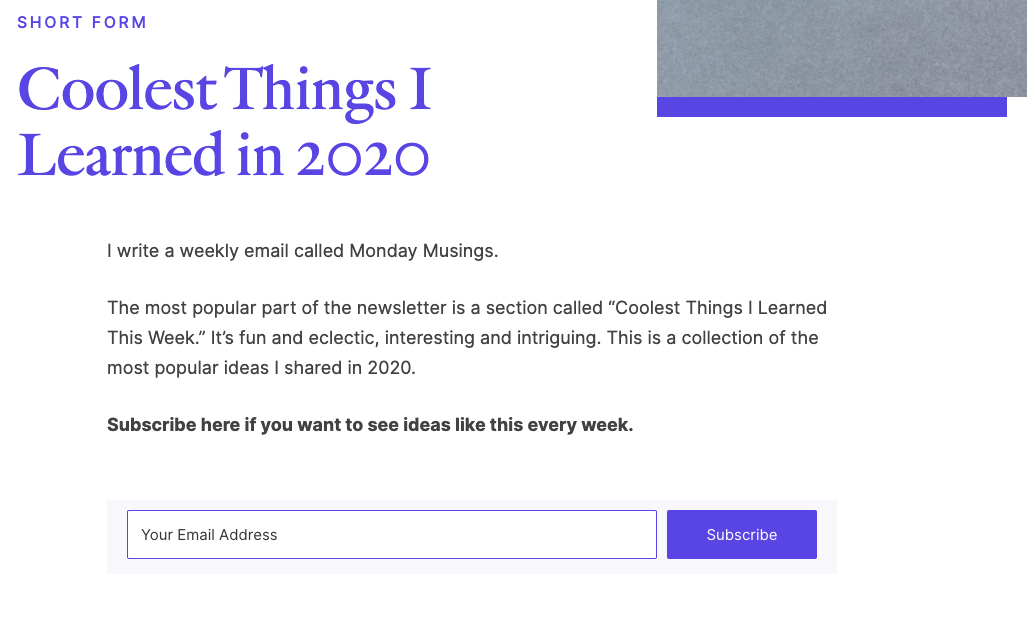
As far as lead magnets go, Perell isn’t a fan: “I hate lead magnets… they’re too much like candy.”
Instead, he prefers attracting new subscribers with courses. One of his courses, for instance, provides 50 days worth of writing advice…

Maybe 50 days seems like a lot, but Perell doesn’t think so.
“I’m a much bigger fan of things like email courses. I have a 50-day email course. That means someone is here for 50 straight days. That’s some powerful stuff. And that really builds a connection, you know. People in that course engage at an average of about 65%. That means they’re reading about 36 of those lessons. That’s pretty powerful. That puts me easily in the top 20 or 30 creators they’ve ever consumed.”
That doesn’t mean you have to use an email course to be successful, but it’s certainly worth considering. At the same time, lead magnets will work well for some newsletters and not so well for others, depending on the disposition of your brand and the content you produce.
In the end, growth means trying a lot of different strategies, getting creative, sticking with what works, and stopping what doesn’t work.
And remember that word-of-mouth is powerful… so even high-quality content on its own can lead to organic growth.
Final Thoughts
What’s the next step?
You now have a pretty good idea of what it takes to create and grow a newsletter that people want to read. You don’t know everything, to be sure… and there’s still a lot to learn.
But the only way to make progress from here is to get started.
Start by finding your niche and designing your newsletter. Then choose the right tools and get your first subscribers. Create engaging content, monetize, and grow, grow, grow.
That’s the process.
And now it’s time for action.
